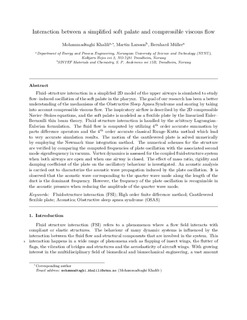| dc.contributor.author | Khalili, Mohammadtaghi | |
| dc.contributor.author | Larsson, Martin | |
| dc.contributor.author | Müller, Bernhard Theodor | |
| dc.date.accessioned | 2017-09-28T06:52:49Z | |
| dc.date.available | 2017-09-28T06:52:49Z | |
| dc.date.created | 2016-11-30T11:53:49Z | |
| dc.date.issued | 2016 | |
| dc.identifier.citation | Journal of Fluids and Structures. 2016, 67 85-105. | nb_NO |
| dc.identifier.issn | 0889-9746 | |
| dc.identifier.uri | http://hdl.handle.net/11250/2457183 | |
| dc.description.abstract | Fluid–structure interaction in a simplified 2D model of the upper airways is simulated to study flow-induced oscillation of the soft palate in the pharynx. The goal of our research has been a better understanding of the mechanisms of the Obstructive Sleep Apnea Syndrome and snoring by taking into account compressible viscous flow. The inspiratory airflow is described by the 2D compressible Navier–Stokes equations, and the soft palate is modeled as a flexible plate by the linearized Euler–Bernoulli thin beam theory. Fluid–structure interaction is handled by the arbitrary Lagrangian–Eulerian formulation. The fluid flow is computed by utilizing 4th order accurate summation by parts difference operators and the 4th order accurate classical Runge–Kutta method which lead to very accurate simulation results. The motion of the cantilevered plate is solved numerically by employing the Newmark time integration method. The numerical schemes for the structure are verified by comparing the computed frequencies of plate oscillation with the associated second mode eigenfrequency in vacuum. Vortex dynamics is assessed for the coupled fluid–structure system when both airways are open and when one airway is closed. The effect of mass ratio, rigidity and damping coefficient of the plate on the oscillatory behavior is investigated. An acoustic analysis is carried out to characterize the acoustic wave propagation induced by the plate oscillation. It is observed that the acoustic wave corresponding to the quarter wave mode along the length of the duct is the dominant frequency. However, the frequency of the plate oscillation is recognizable in the acoustic pressure when reducing the amplitude of the quarter wave mode. | nb_NO |
| dc.language.iso | eng | nb_NO |
| dc.publisher | Elsevier | nb_NO |
| dc.title | Interaction between a simplified soft palate and compressible viscous flow | nb_NO |
| dc.type | Journal article | nb_NO |
| dc.description.version | submittedVersion | nb_NO |
| dc.source.pagenumber | 85-105 | nb_NO |
| dc.source.volume | 67 | nb_NO |
| dc.source.journal | Journal of Fluids and Structures | nb_NO |
| dc.identifier.doi | 10.1016/j.jfluidstructs.2016.09.001 | |
| dc.identifier.cristin | 1406370 | |
| dc.relation.project | Norges forskningsråd: 231741 | nb_NO |
| dc.description.localcode | This is a submitted manuscript of an article published by Elsevier Ltd in Journal of Fluids and Structures, 29 September 2016. | nb_NO |
| cristin.unitcode | 194,64,25,0 | |
| cristin.unitname | Institutt for energi- og prosessteknikk | |
| cristin.ispublished | true | |
| cristin.fulltext | postprint | |
| cristin.qualitycode | 1 | |
